
Original Norman Rockwell Painting of an old sailor getting a girls name crossed out
and his latest port honeys name Tattooed onto his arm
It’s virtually impossible to walk through a mall without spotting people of all ages with tattoos. Tattoos come in all shapes and sizes, and they can appear almost anywhere on someone's body. Permanent cosmetic studios also tattoo on eyebrows, eyeliner and lip liner for those who want their makeup to be permanent. In these cases, you may not even know that you are looking at a tattoo!
Tattoos have steadily gained popularity in the last decade -- a trend that shows little sign of slowing down. In this article, we'll look at all facets of tattooing -- its history and cultural significance, the technology of tattoo machines and how the tattooing process works, and the safety, artistic and legal issues surrounding the practice of tattooing.
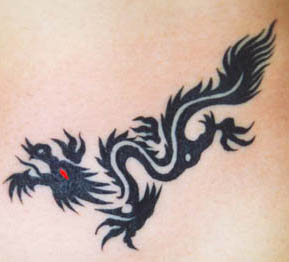
Believe it or not, some scientists say that certain marks on the skin of the Iceman, a mummified human body dating from about 3300 B.C., are tattoos. If that’s true, these markings represent the earliest known evidence of the practice. Tattoos found on Egyptian and Nubian mummies date from about 2000 B.C., and classical authors mention the use of tattoos in connection with Greeks, ancient Germans, Gauls, Thracians and ancient Britons.
Tattooing was rediscovered by Europeans when exploration brought them into contact with Polynesians and American Indians. The word tattoo comes from the Tahitian word tattau, which means "to mark," and was first mentioned in explorer James Cook’s records from his 1769 expedition to the South Pacific. Because tattoos were considered so exotic in European and U.S. societies, tattooed Indians and Polynesians drew crowds at circuses and fairs during the 18th and 19th centuries.
Skin&Ink Tattoo magazine article about Captain Bret's Celtic Tattoos
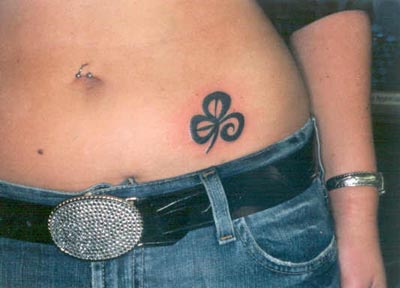
Meaning
The practice of tattooing means different things in different cultures. In early practice,
decoration appears to have been the most common motive for tattooing, and that still holds
true today. In some cultures, tattoos served as identification of the wearer’s rank
or status in a group. For example, the early Romans tattooed slaves and criminals.
Tahitian tattoos served as rites of passage, telling the history of the wearer’s
life. Boys reaching manhood received one tattoo to mark the occasion, while men had
another style done when they married. Sailors traveling to exotic foreign lands began to
collect tattoos as souvenirs of their journeys (a dragon showed that the seaman had served
on a China station), and tattoo parlors sprang up in port cities around the globe.
Custom tattooing (like freehand drawing without a stencil) is increasingly popular with customers, especially those with multiple tattoos.
Tattoo artists say they like the custom work -- that it’s more challenging and artistically satisfying to create something new rather than using a stencil to reproduce a time-worn image such as a rose or an eagle.
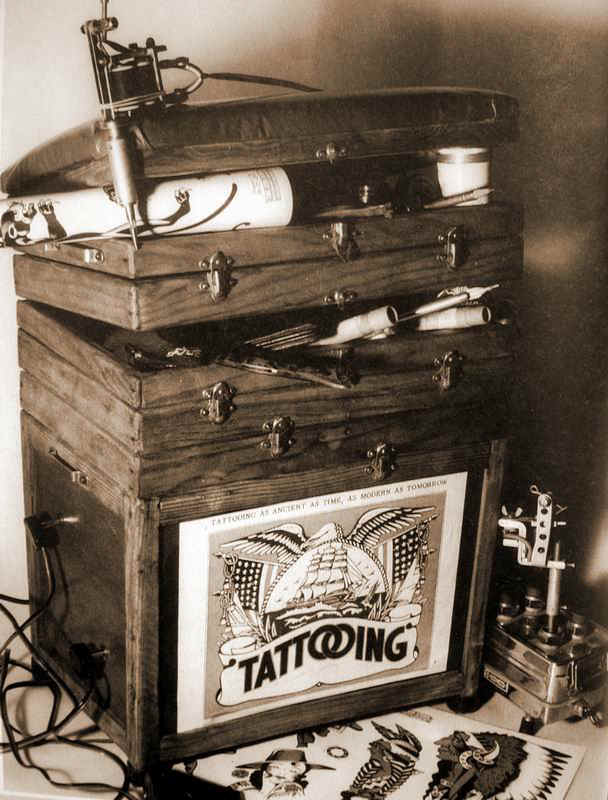
Antique Carnival Tattooing Outfit- Depression Era
Early Tattooing
Methods
An amazing variety of tattooing methods developed in different cultures. In North and
South America, many Indian tribes routinely tattooed the body or the face by simple
pricking, and some tribes in California introduced color into scratches.
Many tribes of the Arctic and Subarctic, mostly Inuit, and some people in eastern Siberia, made needle punctures through which a thread coated with pigment (usually soot) was drawn underneath the skin. In Polynesia and Micronesia, pigment was pricked into the skin by tapping on a tool shaped like a small rake.
The Maori
The Maori people of New Zealand, who are world famous for their tattooing, applied their
wood carving technique to tattooing. In the moko style of Maori tattooing, shallow,
colored grooves in distinctive, complex designs were produced on the face and buttocks by
striking a small bone-cutting tool (used for shaping wood) into the skin. After the
Europeans arrived in the 1700s, the Maori began using the metal that settlers brought for
a more conventional style of puncture tattooing.
The Maori had a custom of preserving the heads of their
tattooed leaders after death as precious family possessions. Over time, they began to
trade some of the heads to collectors for firearms and iron tools. This practice, which is
why there are some of these heads in European museums, was short-lived because of the
fighting and political turmoil it caused.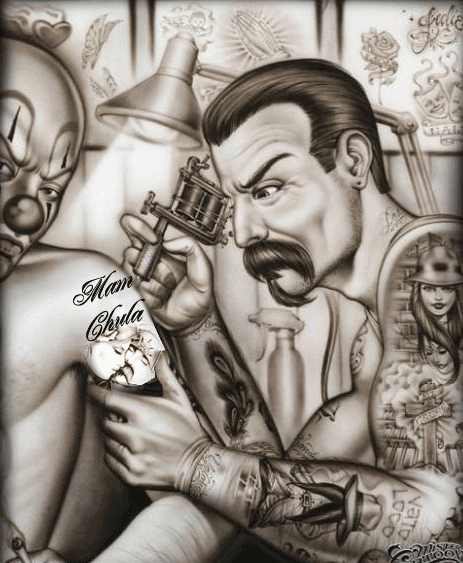
Modern Tattooing
Today, tattoos are created by injecting ink into the skin. Injection is done by a needle attached to a hand-held tool. The tool moves the needle up and down at a rate of several hundred vibrations per minute and penetrates the skin by about one millimeter.
What you see when you look at a tattoo is the ink that's left in the skin after the tattooing. The ink is not in the epidermis, which is the layer of skin that we see and the skin that gets replaced constantly, but instead intermingles with cells in the dermis and shows through the epidermis.
The cells of the dermis are remarkably stable, so the tattoo's ink will last, with minor fading and dispersion, for your entire life!
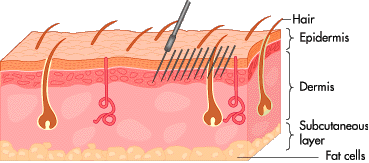
Tattoo needle inserts ink into the Dermal layer as shown
The Tattoo
Machine
The basic idea of the electrically powered tattoo machine is that a needle moves up and
down like in a sewing machine, carrying ink into your skin in the process.
A tattoo machine involves a magnetic vibrator driving the needle up and down.
Today, a tattoo machine is an electrically powered, vertically vibrating steel instrument that resembles a dentist’s drill (and sounds a little like it, too). It is fitted with solid needles that puncture the skin at the rate of 50 to 3,000 times a minute. The sterilized needles are installed in the machine and dipped in ink, which is sucked up through the machine’s tube system. Then, powered by a foot switch much like that on a sewing machine, the tattoo machine uses an up-and-down motion to puncture the top layer of the skin and drive insoluble, micrometer-sized particles of ink into the second (dermal) layer of skin, about one-eighth inch deep.

Typical Tattoo Machine
Thomas Edison Tattooed?
The tattoo machine as we know it today has remained relatively unchanged since it was invented by Samuel O’Reilly and patented in the United States in 1891. In 1876, Thomas Edison patented a tattooing device -- the autographic printer, which was intended as an engraving device for hard surfaces. O’Reilly modified Edison’s machine by changing the tube system and using the cam conversion of a rotary-driven electromagnetic oscillating unit to enable the machine to drive the needle. O’Reilly’s patent was actually only for the tube assembly, since the rest of the machine was identical to Edison’s autographic printer.
Sterilization
Much of the tattoo application process focuses on safety, since any puncture wound -- and
that’s what a tattoo machine is doing to your skin -- holds the potential for
infection and disease transfer.
The only acceptable method of sterilization for killing every living microorganism is an autoclave, a heat/steam/pressure unit (used in hospitals) that achieves and maintains 250 degrees Fahrenheit (121 C) under 10 pounds of pressure for 30 minutes or up to 270 F (132 C) under 15 pounds of pressure for 15 minutes. (Most units run a 55-minute cycle from a cold start.)
Most tattoo materials -- inks, ink cups, gloves and needles -- are used only once to eliminate the possibility of contamination of materials. All reusable materials, such as the needle bar and the tube, must be completely clean, put into special pouches and sterilized in the autoclave. Indicator strips on the packages change color when processing has occurred.
Other equipment includes razors (for shaving the skin, since hair clogs up the tubes and hinders application) and plastic barriers (bags) that are used on spray bottles, tattoo machines and clip cords to prevent cross-contamination.
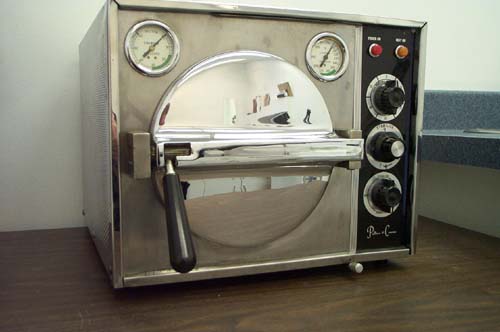
Typical Tattoo Shop Sterilizer
Prep Work
The tattoo artist, who has washed and inspected hands for cuts or abrasions and
disinfected the work area with an EPA-approved viricidal, dons fresh gloves and generally
follows this procedure:
- Places plastic bags on spray bottles
- Explains the sterilization process to client
- Opens up single-service, autoclave sterilized equipment in front of client
- Shaves and disinfects (with a mixture of water and antiseptic green soap) the area to be tattooed
With the outline (stencil) of the tattoo in place -- or the outline of a custom tattoo drawn by hand onto the skin -- the actual tattooing begins.
Making the
Outline
Using one single-tipped needle, the artist starts at the bottom of the right-hand side and
works up (lefties generally start on the left side), so the stencil won’t be lost
when the artist cleans a permanent line. For single-needle work, a thinner black ink than
that used for shading is used, because thinner ink can be easily wiped away from the skin
without smearing.
As this happens, the tattoo machine is buzzing and smooth clear lines should be emerging as the needle pierces the skin, applies the ink and gradually lifts out of the skin in a steady motion. (Experts say this is where the professionals show their mettle: In order to create clear lines and proper depth, the tattoo artist must understand how deep the needles actually need to go to produce a permanent line. Not going deep enough will create scratchy lines after healing, and going too deep will cause excessive pain and bleeding.)
Shading
Once the outline is complete, the area is thoroughly cleaned with antiseptic soap and
water. Then, the outline is thickened and shading is added. The tattoo artist will use a
combination of needles. If this isn't done correctly, shadowed lines, excessive pain and
delayed healing will result. Again, everything must be autoclaved before use.
Using a thicker, blacker ink, the artist goes over the outline creating an even, solid line. Shading creates special effects. Each tattoo artist works differently, depending upon his or her training and preference.
Color
After the shading is done, the tattoo is cleaned again and is now ready for color. When
applying color, the artist overlaps each line of color to ensure solid, even hues with no
“holidays” -- uneven areas where color has either lifted out during healing or
where the tattoo artist simply missed a section of skin.
The tattoo is again sprayed and cleaned and pressure is applied using a disposable towel to remove any blood and plasma excreted during the tattooing process. According to medical experts, some bleeding always occurs in tattooing, but under normal conditions (no alcohol or illegal drugs in the system, no fatigue, no tattooing over scar tissue), most stops within a few minutes after the tattoo is completed. (Reputable tattoo artists won’t tattoo those who are sick, drunk, high or pregnant, and they won’t apply pornographic, racist or gang tattoos.)


Tattoo Studio Tattoo Color Bottles

Time and Money
How long the process takes depends on the individual style of the artist and the intricacy
of the tattoo design. A custom piece can take multiple hours and require a number of
visits to the tattoo parlor.
How much does a tattoo cost? A small one -- under 1 inch -- should cost from $50 to $100. As you might expect, custom tattoos are more expensive, as are bigger designs that cover large areas of the body. Prices for these more elaborate applications are whatever the market will bear, according to tattoo artists. (Tattoo removal is considerably more expensive -- $400 to $800 for a small tattoo; over $1,000 for a large one -- but we'll discuss that later.)
The Pain Issue!
Being snapped by a rubber band, a slight tickling, a bee sting, a sunburn, being pinched,
“pins ‘n needles” like when your foot’s asleep, numb, pinpricks,
tingling, like a drill going into your skin, uncomfortable -- all of these phrases have
been used to describe what it feels like to get a tattoo.
Your personal tolerance for pain, the size and type of your tattoo and the skill of the artist help determine the amount of pain involved. If you have difficulty with an injection at the doctor’s office or if the sight of blood makes you queasy, you might want to think twice before visiting the tattoo parlor. (Try one of the massively popular temporary tattoos or henna tattoos, also temporary, that Madonna and other stars have made popular. They offer the "coolness" of a tattoo without the pain, risk and expense.)
Pain also depends on the location of your tattoo. The lower back and ankle are popular places for tattoos, but it’s much less painful to get one on your chest or upper arm.
Getting a tattoo on your arm or chest is less painful than on an area like the ankle because skin right above your bones tends to be more sensitive to needles, while there’s extra body mass in the upper arm or chest to cushion the bones.
Getting a tattoo on your arm or chest is less painful than on an area like the ankle because skin right above your bones tends to be more sensitive to needles, while there’s extra body mass in the upper arm or chest to cushion the bones.
Caring for a
New Tattoo
Taking care with a new tattoo can prevent health problems and also ensure that the quality
of the image is protected. Here’s what you need to do:
- Remove bandage from tattoo one to two hours after completion.
- Wash gently with cool or lukewarm water, using a mild antibacterial soap.
- Pat dry. (Don’t rub!)
- Apply very thin coats of Bacitracin or A&D Ointment (not regular petroleum jelly) and work well into the skin. (If you can see the ointment on your skin, you’re using too much and it could pull color out of your skin, tattoo artists warn.)
- Don’t soak the tattoo in water or let the shower pound directly on it.
- Avoid sun, sea and swimming pool until healed.
- Refrain from picking at any scab that may form -- it will fall off as it heals, usually in one to three weeks.
- Use ice packs if swelling or redness occurs.
- Call your doctor if you have even the slightest signs of infection!
Health Risks
Before you make a decision to get a tattoo, do yourself a favor and read about possible
health issues associated with the practice.
The Alliance of Professional Tattooists, a non-profit, educational organization that helps establish and implement professional health standards within the tattoo industry, says that since the needles used in tattooing are solid (not hollow like a syringe), and HIV doesn't live outside the body for very long, transmission is unlikely. According to the Centers for Disease Control and Prevention, there has not been a documented case of AIDS transmission from a tattoo.
Professional tattoo artists, who contend that the number of health problems is small compared with the number of people being tattooed, have taken steps to minimize these risks. However, such diseases can still be transmitted because needles are not always disposed of after each patient and methods of sterilization are sometimes inadequate.
In addition to the infections that can occur if proper care isn't taken after the tattooing session, allergic reactions to pigments are also a risk. Doctors say that none of the 50-plus colors and shades of pigment used in tattooing are regulated by the U.S. Food and Drug Administration. (Dispersion inks are traditionally used for tattooing, but because the inks contain resin, acrylic or glycol or all three, there is a trend toward use of natural pre-dispersed colors made with organic pigments.)
Health Precautions
A list of rules known as Universal Precautions is part of the Bloodborne Pathogens Rule
issued by the U.S. Environmental Protection Agency (EPA). These apply in any health
service setting in which exposure to bodily fluids and blood is a risk. This also applies
to tattoo parlors!
Dr. Kris Sperry, a forensic pathologist and chief medical examiner for the state of Georgia, lead a group of physicians known as Tattoodocs, who taught infection control in the tattoo and piercing environment. They offered these guidelines to tattoo artists (you can help ensure your safety by making sure these guidelines are followed by your tattoo artist):
- During the procedure, check gloves regularly for small pinhole tears since ointment can actually erode latex.
- Refrain from touching eyes, mouth, ears or nose during application.
- Do no smoke with gloves on.
- Pour out ink in advance; when adding more palette, use a clean tissue to open the pigment bottle, being careful not to allow the nozzle to come into contact with contaminated trays.
- When rinsing tubes for color changes, rinse carefully and pat dry -- don’t blow excess water from the tube.
- Spray liquid soap into a tissue and wipe away excess fluids from tattoo -- don’t spray directly onto bleeding area because blood can become aerosolized.
- If a pen is used for freehand drawing on the skin, give it to the customer when completed (the pen should be medical grade and sterile).
- Bandage client with packaged, sterile, non-stick-variety bandage; use gauze to secure bandage and tape it to the site using hypoallergenic products.
- Remove gloves and wash hands.
- Give proper care instructions.
Watch the Hands
Safety measures taken by the tattoo artist include acute attention to the hands, which
must be inspected for cuts, sores (these should be covered with a Band-Aid) and hangnails
and should have short nails to prevent punctures to latex and vinyl gloves. (Medical
studies have shown that impacted blood can remain for up to five days underneath the
fingernail if hand washing and gloves aren’t properly handled.)
Unless chemicals, heat, cold or trauma have damaged the hands, infectious organisms have a hard time establishing themselves on the surface of the skin, experts say. Tattoo artists who have lesions, dermatitis or allergic reactions to gloves should refrain from tattooing until the condition clears up. Using gloves has increased the importance of frequent and proper hand washing since bacteria beneath gloves thrive in the damp, warm environment and may irritate the skin.
Now for an extremely important health safety point: Don’t let a friend try to tattoo you! According to doctors at the Children’s Medical Center, University of Massachusetts, studies show that most adolescents do not get their tattoos from professional parlors -- which require an over-18 ID or parental permission -- but from friends or amateurs who use makeshift tools such as pens, erasers and paper clips with little if any sanitary precautions. This is extremely dangerous. The measures taken by professionals protect you from disease and infection.
Identifying a Safe Tattoo Parlor
Other than the use of Universal Procedures and laws requiring that minors be tattooed only
with parental permission, there are few regulations covering tattooing. Tattoo parlors
must be licensed; this happens when artists qualify by completing a health department
course on infectious disease transmission and passing an exam, but businesses aren’t
regularly inspected. (Legalization allows anyone to acquire a machine, get a license and
start tattooing whether they have any artistic ability or not -- a situation that tattoo
artists object to.) Here are some basic steps you can take to help ensure that you’re
choosing a safe tattoo parlor:
- Look around to see if the studio is clean and professional. That says a lot!
- Ask questions: Is there an autoclave? Are the needles and other materials single-use? Are EPA-approved disinfectants used? Are gloves being worn? (Professional tattoo artists won’t mind the questions.)
- Play watchdog with the tattoo artist to be sure safety measures are being followed in the application of your tattoo.
- Make sure all needles are opened in front of you.
- Membership in professional organizations is not required, but artists who participate are probably better informed about trends, innovations and safety issues.
Other Considerations
After you’ve explored the tattoo process and learned about all the health/safety
considerations, here are several more points to consider:
- Think long and hard about the fact that a tattoo is permanent. What’s cool at 18 might not be very appealing on a 40-year-old you!
- Tattoo removal is considerably more painful and expensive than tattooing. The process usually takes several sessions and offers varying results. Doctors say tattoos can be lightened but not always completely removed. (You can learn more in How Tattoo Removal Works.)
-
Consider your career interests and plans -- will sporting a highly
visible tattoo hinder your success or effectiveness later on?
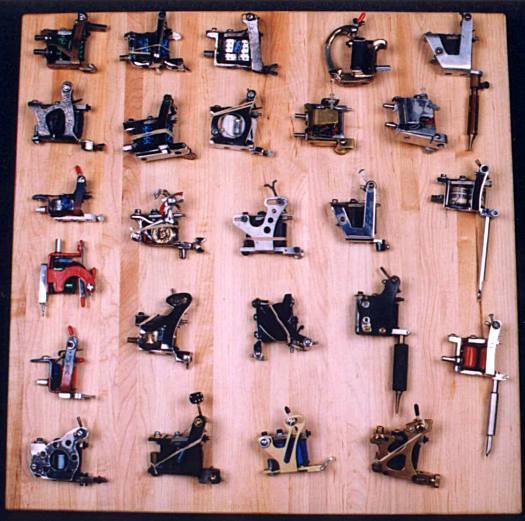
Tattoo Machines
The mechanics behind the tattoo machine have remained relatively unchanged for nearly 100 years. Thomas Edison in 1877 patented an electric marking pencil. A man named Samuel O'Reilly took Edisons design and made a few small changes and patented it as an electric tattoo machine. Shown here are many different styles of machine frames. However, underneath most of them, Edisons two-coil design remains the same.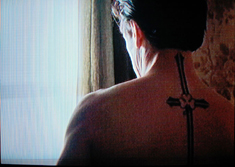
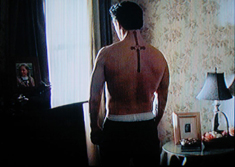
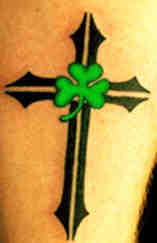
Mystic River Tattoo
Sean Penn Back Tattoo
CLICK DOWNLOAD THIS TATTOO DESIGN NOW
Tattoo that Captain Bret Designed that was used in Clint Eastwood's movie"MYSTIC RIVER" staring Sean Penn as the character "Jimmy Markum" a South Boston Irish mobster with this celtic styled cross Tattooed on his back
click for my Facebook
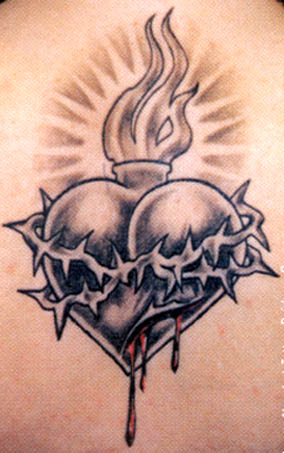
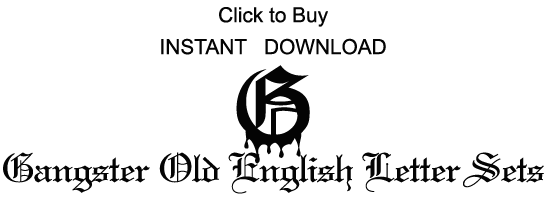

(Click)


We do ALL Tattoo styles, NOT JUST Tribal & Celtic
Click for Home Index Page
Celtic Tattoo Photos Tribal Tattoo Photos
Miscellaneous Tattoo Photographs
The Book of Kells (Pagan Celt Viking & Pict Influence on Art)
Celtic Tattoo History Page #1 Page #2 Page #3
Tribal Tattoo History Page #1 Page #2 Page #3
Celtic Mythology Page #1 Page #2 Page #3
Tree of Life Designs and History
A Cultural History of the Modern Tattoo Community
Body Parts (Or Modern Mutations)
Current Tattoo Trends
How Tattoos Work
Directions Hours Discount Coupon F.A.Q.s
Pictures of Tattoo Shop & All our Tattoo Designs
Tattoo Care Instructions
Design Service

These designs, pictures, Photographs, JPG,s,Gifs, files, logos, Tattoos, images, content are used exclusively by Captain Bret's Tattoo Shop Inc. and represents our company, they are our intellectual property 1981 All rights reserved. All Tattoos By Artist Captain Bret A. Lohnes 1981
NO commercial or non-commercial reproductions allowed or tolerated without valid license from Captain Bret's Tattoo Shop Inc.
All designs and images/content/compilation herein are Copyright 1981. Trade Mark-Service
Mark protections exist. Said Copyright, Copyrights, Service Marks, Trade Marks
may be filed, owned, by all, some, or individually by the following, Bret
A. Lohnes, Captain Bret's Tattoo Shop Inc. and www.tribal-celtic-tattoo.com
copyright 1981

Original Norman Rockwell Painting of an old sailor getting a girls name crossed out
and his latest port honeys name Tattooed onto his arm
It’s virtually impossible to walk through a mall without spotting people of all ages with tattoos. Tattoos come in all shapes and sizes, and they can appear almost anywhere on someone's body. Permanent cosmetic studios also tattoo on eyebrows, eyeliner and lip liner for those who want their makeup to be permanent. In these cases, you may not even know that you are looking at a tattoo!
Tattoos have steadily gained popularity in the last decade -- a trend that shows little sign of slowing down. In this article, we'll look at all facets of tattooing -- its history and cultural significance, the technology of tattoo machines and how the tattooing process works, and the safety, artistic and legal issues surrounding the practice of tattooing.

Believe it or not, some scientists say that certain marks on the skin of the Iceman, a mummified human body dating from about 3300 B.C., are tattoos. If that’s true, these markings represent the earliest known evidence of the practice. Tattoos found on Egyptian and Nubian mummies date from about 2000 B.C., and classical authors mention the use of tattoos in connection with Greeks, ancient Germans, Gauls, Thracians and ancient Britons.
Tattooing was rediscovered by Europeans when exploration brought them into contact with Polynesians and American Indians. The word tattoo comes from the Tahitian word tattau, which means "to mark," and was first mentioned in explorer James Cook’s records from his 1769 expedition to the South Pacific. Because tattoos were considered so exotic in European and U.S. societies, tattooed Indians and Polynesians drew crowds at circuses and fairs during the 18th and 19th centuries.
Skin&Ink Tattoo magazine article about Captain Bret's Celtic Tattoos

Meaning
The practice of tattooing means different things in different cultures. In early practice,
decoration appears to have been the most common motive for tattooing, and that still holds
true today. In some cultures, tattoos served as identification of the wearer’s rank
or status in a group. For example, the early Romans tattooed slaves and criminals.
Tahitian tattoos served as rites of passage, telling the history of the wearer’s
life. Boys reaching manhood received one tattoo to mark the occasion, while men had
another style done when they married. Sailors traveling to exotic foreign lands began to
collect tattoos as souvenirs of their journeys (a dragon showed that the seaman had served
on a China station), and tattoo parlors sprang up in port cities around the globe.
Custom tattooing (like freehand drawing without a stencil) is increasingly popular with customers, especially those with multiple tattoos.
Tattoo artists say they like the custom work -- that it’s more challenging and artistically satisfying to create something new rather than using a stencil to reproduce a time-worn image such as a rose or an eagle.

Antique Carnival Tattooing Outfit- Depression Era
Early Tattooing
Methods
An amazing variety of tattooing methods developed in different cultures. In North and
South America, many Indian tribes routinely tattooed the body or the face by simple
pricking, and some tribes in California introduced color into scratches.
Many tribes of the Arctic and Subarctic, mostly Inuit, and some people in eastern Siberia, made needle punctures through which a thread coated with pigment (usually soot) was drawn underneath the skin. In Polynesia and Micronesia, pigment was pricked into the skin by tapping on a tool shaped like a small rake.
The Maori
The Maori people of New Zealand, who are world famous for their tattooing, applied their
wood carving technique to tattooing. In the moko style of Maori tattooing, shallow,
colored grooves in distinctive, complex designs were produced on the face and buttocks by
striking a small bone-cutting tool (used for shaping wood) into the skin. After the
Europeans arrived in the 1700s, the Maori began using the metal that settlers brought for
a more conventional style of puncture tattooing.
The Maori had a custom of preserving the heads of their
tattooed leaders after death as precious family possessions. Over time, they began to
trade some of the heads to collectors for firearms and iron tools. This practice, which is
why there are some of these heads in European museums, was short-lived because of the
fighting and political turmoil it caused.
Modern Tattooing
Today, tattoos are created by injecting ink into the skin. Injection is done by a needle attached to a hand-held tool. The tool moves the needle up and down at a rate of several hundred vibrations per minute and penetrates the skin by about one millimeter.
What you see when you look at a tattoo is the ink that's left in the skin after the tattooing. The ink is not in the epidermis, which is the layer of skin that we see and the skin that gets replaced constantly, but instead intermingles with cells in the dermis and shows through the epidermis.
The cells of the dermis are remarkably stable, so the tattoo's ink will last, with minor fading and dispersion, for your entire life!

Tattoo needle inserts ink into the Dermal layer as shown
The Tattoo
Machine
The basic idea of the electrically powered tattoo machine is that a needle moves up and
down like in a sewing machine, carrying ink into your skin in the process.
A tattoo machine involves a magnetic vibrator driving the needle up and down.
Today, a tattoo machine is an electrically powered, vertically vibrating steel instrument that resembles a dentist’s drill (and sounds a little like it, too). It is fitted with solid needles that puncture the skin at the rate of 50 to 3,000 times a minute. The sterilized needles are installed in the machine and dipped in ink, which is sucked up through the machine’s tube system. Then, powered by a foot switch much like that on a sewing machine, the tattoo machine uses an up-and-down motion to puncture the top layer of the skin and drive insoluble, micrometer-sized particles of ink into the second (dermal) layer of skin, about one-eighth inch deep.

Typical Tattoo Machine
Thomas Edison Tattooed?
The tattoo machine as we know it today has remained relatively unchanged since it was invented by Samuel O’Reilly and patented in the United States in 1891. In 1876, Thomas Edison patented a tattooing device -- the autographic printer, which was intended as an engraving device for hard surfaces. O’Reilly modified Edison’s machine by changing the tube system and using the cam conversion of a rotary-driven electromagnetic oscillating unit to enable the machine to drive the needle. O’Reilly’s patent was actually only for the tube assembly, since the rest of the machine was identical to Edison’s autographic printer.
Sterilization
Much of the tattoo application process focuses on safety, since any puncture wound -- and
that’s what a tattoo machine is doing to your skin -- holds the potential for
infection and disease transfer.
The only acceptable method of sterilization for killing every living microorganism is an autoclave, a heat/steam/pressure unit (used in hospitals) that achieves and maintains 250 degrees Fahrenheit (121 C) under 10 pounds of pressure for 30 minutes or up to 270 F (132 C) under 15 pounds of pressure for 15 minutes. (Most units run a 55-minute cycle from a cold start.)
Most tattoo materials -- inks, ink cups, gloves and needles -- are used only once to eliminate the possibility of contamination of materials. All reusable materials, such as the needle bar and the tube, must be completely clean, put into special pouches and sterilized in the autoclave. Indicator strips on the packages change color when processing has occurred.
Other equipment includes razors (for shaving the skin, since hair clogs up the tubes and hinders application) and plastic barriers (bags) that are used on spray bottles, tattoo machines and clip cords to prevent cross-contamination.

Typical Tattoo Shop Sterilizer
Prep Work
The tattoo artist, who has washed and inspected hands for cuts or abrasions and
disinfected the work area with an EPA-approved viricidal, dons fresh gloves and generally
follows this procedure:
- Places plastic bags on spray bottles
- Explains the sterilization process to client
- Opens up single-service, autoclave sterilized equipment in front of client
- Shaves and disinfects (with a mixture of water and antiseptic green soap) the area to be tattooed
With the outline (stencil) of the tattoo in place -- or the outline of a custom tattoo drawn by hand onto the skin -- the actual tattooing begins.
Making the
Outline
Using one single-tipped needle, the artist starts at the bottom of the right-hand side and
works up (lefties generally start on the left side), so the stencil won’t be lost
when the artist cleans a permanent line. For single-needle work, a thinner black ink than
that used for shading is used, because thinner ink can be easily wiped away from the skin
without smearing.
As this happens, the tattoo machine is buzzing and smooth clear lines should be emerging as the needle pierces the skin, applies the ink and gradually lifts out of the skin in a steady motion. (Experts say this is where the professionals show their mettle: In order to create clear lines and proper depth, the tattoo artist must understand how deep the needles actually need to go to produce a permanent line. Not going deep enough will create scratchy lines after healing, and going too deep will cause excessive pain and bleeding.)
Shading
Once the outline is complete, the area is thoroughly cleaned with antiseptic soap and
water. Then, the outline is thickened and shading is added. The tattoo artist will use a
combination of needles. If this isn't done correctly, shadowed lines, excessive pain and
delayed healing will result. Again, everything must be autoclaved before use.
Using a thicker, blacker ink, the artist goes over the outline creating an even, solid line. Shading creates special effects. Each tattoo artist works differently, depending upon his or her training and preference.
Color
After the shading is done, the tattoo is cleaned again and is now ready for color. When
applying color, the artist overlaps each line of color to ensure solid, even hues with no
“holidays” -- uneven areas where color has either lifted out during healing or
where the tattoo artist simply missed a section of skin.
The tattoo is again sprayed and cleaned and pressure is applied using a disposable towel to remove any blood and plasma excreted during the tattooing process. According to medical experts, some bleeding always occurs in tattooing, but under normal conditions (no alcohol or illegal drugs in the system, no fatigue, no tattooing over scar tissue), most stops within a few minutes after the tattoo is completed. (Reputable tattoo artists won’t tattoo those who are sick, drunk, high or pregnant, and they won’t apply pornographic, racist or gang tattoos.)


Tattoo Studio Tattoo Color Bottles

Time and Money
How long the process takes depends on the individual style of the artist and the intricacy
of the tattoo design. A custom piece can take multiple hours and require a number of
visits to the tattoo parlor.
How much does a tattoo cost? A small one -- under 1 inch -- should cost from $50 to $100. As you might expect, custom tattoos are more expensive, as are bigger designs that cover large areas of the body. Prices for these more elaborate applications are whatever the market will bear, according to tattoo artists. (Tattoo removal is considerably more expensive -- $400 to $800 for a small tattoo; over $1,000 for a large one -- but we'll discuss that later.)
The Pain Issue!
Being snapped by a rubber band, a slight tickling, a bee sting, a sunburn, being pinched,
“pins ‘n needles” like when your foot’s asleep, numb, pinpricks,
tingling, like a drill going into your skin, uncomfortable -- all of these phrases have
been used to describe what it feels like to get a tattoo.
Your personal tolerance for pain, the size and type of your tattoo and the skill of the artist help determine the amount of pain involved. If you have difficulty with an injection at the doctor’s office or if the sight of blood makes you queasy, you might want to think twice before visiting the tattoo parlor. (Try one of the massively popular temporary tattoos or henna tattoos, also temporary, that Madonna and other stars have made popular. They offer the "coolness" of a tattoo without the pain, risk and expense.)
Pain also depends on the location of your tattoo. The lower back and ankle are popular places for tattoos, but it’s much less painful to get one on your chest or upper arm.
Getting a tattoo on your arm or chest is less painful than on an area like the ankle because skin right above your bones tends to be more sensitive to needles, while there’s extra body mass in the upper arm or chest to cushion the bones.
Getting a tattoo on your arm or chest is less painful than on an area like the ankle because skin right above your bones tends to be more sensitive to needles, while there’s extra body mass in the upper arm or chest to cushion the bones.
Caring for a
New Tattoo
Taking care with a new tattoo can prevent health problems and also ensure that the quality
of the image is protected. Here’s what you need to do:
- Remove bandage from tattoo one to two hours after completion.
- Wash gently with cool or lukewarm water, using a mild antibacterial soap.
- Pat dry. (Don’t rub!)
- Apply very thin coats of Bacitracin or A&D Ointment (not regular petroleum jelly) and work well into the skin. (If you can see the ointment on your skin, you’re using too much and it could pull color out of your skin, tattoo artists warn.)
- Don’t soak the tattoo in water or let the shower pound directly on it.
- Avoid sun, sea and swimming pool until healed.
- Refrain from picking at any scab that may form -- it will fall off as it heals, usually in one to three weeks.
- Use ice packs if swelling or redness occurs.
- Call your doctor if you have even the slightest signs of infection!
Health Risks
Before you make a decision to get a tattoo, do yourself a favor and read about possible
health issues associated with the practice.
The Alliance of Professional Tattooists, a non-profit, educational organization that helps establish and implement professional health standards within the tattoo industry, says that since the needles used in tattooing are solid (not hollow like a syringe), and HIV doesn't live outside the body for very long, transmission is unlikely. According to the Centers for Disease Control and Prevention, there has not been a documented case of AIDS transmission from a tattoo.
Professional tattoo artists, who contend that the number of health problems is small compared with the number of people being tattooed, have taken steps to minimize these risks. However, such diseases can still be transmitted because needles are not always disposed of after each patient and methods of sterilization are sometimes inadequate.
In addition to the infections that can occur if proper care isn't taken after the tattooing session, allergic reactions to pigments are also a risk. Doctors say that none of the 50-plus colors and shades of pigment used in tattooing are regulated by the U.S. Food and Drug Administration. (Dispersion inks are traditionally used for tattooing, but because the inks contain resin, acrylic or glycol or all three, there is a trend toward use of natural pre-dispersed colors made with organic pigments.)
Health Precautions
A list of rules known as Universal Precautions is part of the Bloodborne Pathogens Rule
issued by the U.S. Environmental Protection Agency (EPA). These apply in any health
service setting in which exposure to bodily fluids and blood is a risk. This also applies
to tattoo parlors!
Dr. Kris Sperry, a forensic pathologist and chief medical examiner for the state of Georgia, lead a group of physicians known as Tattoodocs, who taught infection control in the tattoo and piercing environment. They offered these guidelines to tattoo artists (you can help ensure your safety by making sure these guidelines are followed by your tattoo artist):
- During the procedure, check gloves regularly for small pinhole tears since ointment can actually erode latex.
- Refrain from touching eyes, mouth, ears or nose during application.
- Do no smoke with gloves on.
- Pour out ink in advance; when adding more palette, use a clean tissue to open the pigment bottle, being careful not to allow the nozzle to come into contact with contaminated trays.
- When rinsing tubes for color changes, rinse carefully and pat dry -- don’t blow excess water from the tube.
- Spray liquid soap into a tissue and wipe away excess fluids from tattoo -- don’t spray directly onto bleeding area because blood can become aerosolized.
- If a pen is used for freehand drawing on the skin, give it to the customer when completed (the pen should be medical grade and sterile).
- Bandage client with packaged, sterile, non-stick-variety bandage; use gauze to secure bandage and tape it to the site using hypoallergenic products.
- Remove gloves and wash hands.
- Give proper care instructions.
Watch the Hands
Safety measures taken by the tattoo artist include acute attention to the hands, which
must be inspected for cuts, sores (these should be covered with a Band-Aid) and hangnails
and should have short nails to prevent punctures to latex and vinyl gloves. (Medical
studies have shown that impacted blood can remain for up to five days underneath the
fingernail if hand washing and gloves aren’t properly handled.)
Unless chemicals, heat, cold or trauma have damaged the hands, infectious organisms have a hard time establishing themselves on the surface of the skin, experts say. Tattoo artists who have lesions, dermatitis or allergic reactions to gloves should refrain from tattooing until the condition clears up. Using gloves has increased the importance of frequent and proper hand washing since bacteria beneath gloves thrive in the damp, warm environment and may irritate the skin.
Now for an extremely important health safety point: Don’t let a friend try to tattoo you! According to doctors at the Children’s Medical Center, University of Massachusetts, studies show that most adolescents do not get their tattoos from professional parlors -- which require an over-18 ID or parental permission -- but from friends or amateurs who use makeshift tools such as pens, erasers and paper clips with little if any sanitary precautions. This is extremely dangerous. The measures taken by professionals protect you from disease and infection.
Identifying a Safe Tattoo Parlor
Other than the use of Universal Procedures and laws requiring that minors be tattooed only
with parental permission, there are few regulations covering tattooing. Tattoo parlors
must be licensed; this happens when artists qualify by completing a health department
course on infectious disease transmission and passing an exam, but businesses aren’t
regularly inspected. (Legalization allows anyone to acquire a machine, get a license and
start tattooing whether they have any artistic ability or not -- a situation that tattoo
artists object to.) Here are some basic steps you can take to help ensure that you’re
choosing a safe tattoo parlor:
- Look around to see if the studio is clean and professional. That says a lot!
- Ask questions: Is there an autoclave? Are the needles and other materials single-use? Are EPA-approved disinfectants used? Are gloves being worn? (Professional tattoo artists won’t mind the questions.)
- Play watchdog with the tattoo artist to be sure safety measures are being followed in the application of your tattoo.
- Make sure all needles are opened in front of you.
- Membership in professional organizations is not required, but artists who participate are probably better informed about trends, innovations and safety issues.
Other Considerations
After you’ve explored the tattoo process and learned about all the health/safety
considerations, here are several more points to consider:
- Think long and hard about the fact that a tattoo is permanent. What’s cool at 18 might not be very appealing on a 40-year-old you!
- Tattoo removal is considerably more painful and expensive than tattooing. The process usually takes several sessions and offers varying results. Doctors say tattoos can be lightened but not always completely removed. (You can learn more in How Tattoo Removal Works.)
-
Consider your career interests and plans -- will sporting a highly
visible tattoo hinder your success or effectiveness later on?

Tattoo Machines
The mechanics behind the tattoo machine have remained relatively unchanged for nearly 100 years. Thomas Edison in 1877 patented an electric marking pencil. A man named Samuel O'Reilly took Edisons design and made a few small changes and patented it as an electric tattoo machine. Shown here are many different styles of machine frames. However, underneath most of them, Edisons two-coil design remains the same.


Mystic River Tattoo
Sean Penn Back Tattoo
CLICK DOWNLOAD THIS TATTOO DESIGN NOW
Tattoo that Captain Bret Designed that was used in Clint Eastwood's movie"MYSTIC RIVER" staring Sean Penn as the character "Jimmy Markum" a South Boston Irish mobster with this celtic styled cross Tattooed on his back
click for my Facebook



(Click)


We do ALL Tattoo styles, NOT JUST Tribal & Celtic
Click for Home Index Page
Celtic Tattoo Photos Tribal Tattoo Photos
Miscellaneous Tattoo Photographs
The Book of Kells (Pagan Celt Viking & Pict Influence on Art)
Celtic Tattoo History Page #1 Page #2 Page #3
Tribal Tattoo History Page #1 Page #2 Page #3
Celtic Mythology Page #1 Page #2 Page #3
Tree of Life Designs and History
A Cultural History of the Modern Tattoo Community
Body Parts (Or Modern Mutations)
Current Tattoo Trends
How Tattoos Work
Directions Hours Discount Coupon F.A.Q.s
Pictures of Tattoo Shop & All our Tattoo Designs
Tattoo Care Instructions
Design Service

These designs, pictures, Photographs, JPG,s,Gifs, files, logos, Tattoos, images, content are used exclusively by Captain Bret's Tattoo Shop Inc. and represents our company, they are our intellectual property 1981 All rights reserved. All Tattoos By Artist Captain Bret A. Lohnes 1981
NO commercial or non-commercial reproductions allowed or tolerated without valid license from Captain Bret's Tattoo Shop Inc.
All designs and images/content/compilation herein are Copyright 1981. Trade Mark-Service
Mark protections exist. Said Copyright, Copyrights, Service Marks, Trade Marks
may be filed, owned, by all, some, or individually by the following, Bret
A. Lohnes, Captain Bret's Tattoo Shop Inc. and www.tribal-celtic-tattoo.com
copyright 1981
3 comments
Click here for commentsAwesome article. Nice tattoo designs. I found more tattoo designs i hope your will like them
ReplyAngelina Jolie Tattoos that will Inspire You
48 Deeply Meaningful Sister Tattoo Ideas
Best 18 Koi Fish Tattoo with Meaning
ReplyYou could attemptwebcare360 and help yourself to overcome
depression by natural means.
How Tattoos Work. - Captain Bret'S Famous Celtic Tattoo ~ Tattoona >>>>> Download Now
Reply>>>>> Download Full
How Tattoos Work. - Captain Bret'S Famous Celtic Tattoo ~ Tattoona >>>>> Download LINK
>>>>> Download Now
How Tattoos Work. - Captain Bret'S Famous Celtic Tattoo ~ Tattoona >>>>> Download Full
>>>>> Download LINK
ConversionConversion EmoticonEmoticon